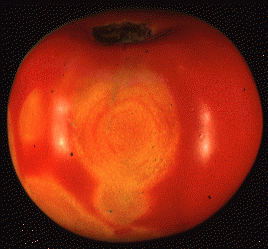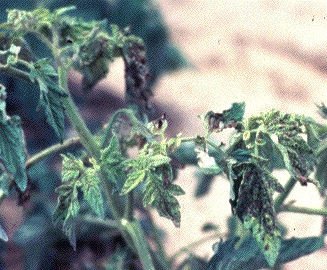 SAN JOAQUIN VALLEY - Tomato Spotted Wilt Virus (TSWV) in tomatoes has been increasing, both in the southern San Joaquin Valley as well as in San Joaquin County, according to Brenna Aegerter, vegetable farm advisor for the county. While there have been “hot spots” of high disease incidence especially down south, “the majority of fields have just a few infected plants,” according to Aegerter.
SAN JOAQUIN VALLEY - Tomato Spotted Wilt Virus (TSWV) in tomatoes has been increasing, both in the southern San Joaquin Valley as well as in San Joaquin County, according to Brenna Aegerter, vegetable farm advisor for the county. While there have been “hot spots” of high disease incidence especially down south, “the majority of fields have just a few infected plants,” according to Aegerter.Symptoms of TSWV are bronzing of leaves followed by the development of necrotic spots and streaks on the foliage and stems, which may be followed by shoot dieback. On fruit, characteristic ringspots develop. On red fruit these can be quite striking, but they are also faintly visible on green fruit, said the veg crop farm advisor who is a specialist in plant pathology.
TSWV has an extremely wide host range, including hundreds of plants species spanning both broadleaves and monocots like as orchids and lilies.
Economic hosts in California include tomato, pepper, beans, corn, lettuce, radicchio, celery and many ornamentals.
“There are many potential weed hosts, including nightshade, purslane and pigweed. This virus is vectored by at least 10 thrips species, including the western flower thrips and the onion thrips,” said Aegerter.
After egg hatch on TSWV-infected plants, the first and second instar larvae acquire the virus. The virus reproduces within the thrips and they can then transmit the virus to healthy plants when they are adults.
“Adults cannot pick up the virus, nor can they pass the virus on to their offspring,” said the farm advisor. “Therefore, in order for a plant to be a source of the virus for new infections and spread, it must support reproduction of both the thrips and the virus.

“In the past, we thought that there was no build-up or secondary spread within tomato fields because tomatoes did not support reproduction of thrips. However, observations this season of very heavily infected tomato fields adjacent to unaffected fields suggest that the vector and virus may be capable of building up within a tomato field. If this turns out to be the case, then controlling the thrips may prove beneficial in reducing the spread of the virus within a tomato field.”
Because there are so many potential sources of inoculum and because their contribution to the problem may change from year to year, there is no clear strategy for positioning tomato crops to avoid infection, according to Aegerter.
Resistant varieties have been developed for both processing and fresh market varieties and these are currently being evaluated.
“Unfortunately, where resistance to TSWV has been introduced into other crops, the resistance has nearly always been overcome by the rapid occurrence of resistance-breaking strains of the virus,” said the farm advisor.
The geographic distribution of the problem (increasing southward in the Central Valley) may reflect the effect of winter temperatures on survival of the vectors. Colder winter temperatures may limit the overwintering of the western flower thrips in the Sacramento Valley. Its development does not progress at below 49 degrees. Higher disease incidence in the San Joaquin Valley might also be due to winter vector host crops such as lettuce and radicchio. The overlap of winter and summer host crops may provide a year-round habitat for the virus and its vector, said the farm advisor.
The disease could be spreading due to mildew winters of late.
Plant pathologists from UC Davis are currently studying the outbreaks in tomatoes in conjunction with Cooperative Extension Farm Advisors who are looking for fields with high incidents of wilt.
“Hopefully we will soon have a better grasp on what factors increase the risk of significant infection,” said the farm advisor.
from Western Farm Press
No comments:
Post a Comment